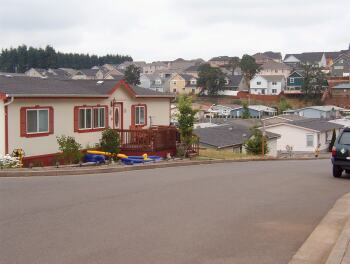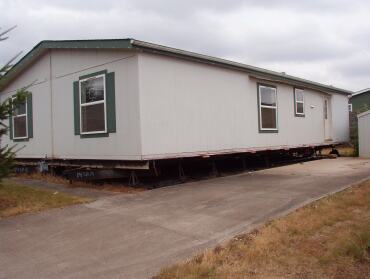
Publisher:
Bonnie King
CONTACT:
Newsroom@Salem-news.com
Advertising:
Adsales@Salem-news.com

~Truth~
~Justice~
~Peace~
TJP
Jul-06-2006 02:32

 TweetFollow @OregonNews
TweetFollow @OregonNews
Study Finds Many Trailer Parks, And Families May Never Break The Label of 'Trailer Trash'
Salem-News.comThe study reveals a huge social and economic crisis for families living in America’s rural trailer parks.
 Photos by: Kevin Hays |
(CORVALLIS) - The denizens of America's rural trailer parks have heard all the snide comments about their homes – and they have been labeled everything from "trailer trash" to "tornado magnets" – but beneath that ridicule lie acute needs and real concerns, according to a new study.
“While mobile homes have emerged as the housing of choice among low-income rural households, many mobile home-dwellers face exorbitant interest rates, social instability from high turnover rates in trailer park neighborhoods, stigmatization and discrimination in the community and schools, and a lack of opportunities for their children,” said Katherine A. MacTavish, an assistant professor of human development and sciences at Oregon State University and lead author of the study.
“All of these factors work to compromise how well this kind of housing works for low-income rural families and for small-town communities,” she added.
Results of the research – based on field studies in rural Oregon, Illinois, New Mexico and North Carolina – will be published in the Georgetown Journal of Poverty Law and Policy this month. The study was funded by the National Institutes of Health and the U.S. Department of Agriculture. Co-authors are Sonya Salamon of the University of Illinois and Michelle Ely of North Carolina A&T State University.
“The rural families that we talked to were uniformly proud of their homes,” said OSU’s MacTavish. “But they face a number of challenges, from financing those mobile homes to maintaining their structural integrity, to dealing with social stigmatization.”
In their study, the researchers found that because mobile homes are classified as personal rather than “real” property, they are often financed with chattel loans that have higher interest rates – averaging from 10 to 14 percent. Since many of the residents already are in low-income brackets, they become “cost-burdened” by ownership. As much as 50 to 60 percent of their income gets tied up in housing costs, including mortgages, lot rental and utilities.
Financing mobile home purchases through 15- and 30-year mortgages becomes problematic, the researchers say, because the dwellings lose approximately half of their value within three years.
“If the family decides to sell their home, they often receive less than the amount they still owe on their loans,” MacTavish said. “By the time you factor in sudden increases in lot rental prices and high utility bills, especially in winter, mobile home ownership can become a costly entrapment for working poor families.”
Mobile home residents also face challenges in maintaining the physical and structural integrity of their dwellings, the researchers found. Most only received, at best, a one-year warranty upon purchasing their mobile homes and low-income rural families were more likely to purchase lower-end or used models that had no warranty.
Despite displaying pride in ownership, many residents faced repairs or replacement for basic structural features including doors, windows, floors and roofs.
The researchers point to a survey done by Consumers Union that found mobile home owners experienced high incidence of plumbing problems, faulty sub-flooring, and leaking windows, doors and roofs. Other studies have found that mobile homes have twice the rate of fire deaths of all other home types combined, MacTavish said.
“Older mobile homes – those built before 1976 – had a propensity for burning quickly and to the ground, and people refer to them as ‘firetraps’ and ‘matchsticks,’” MacTavish said.
Wind is another issue, the researchers say, pointing to a study by HUD that found manufactured homes exposed to normal seasonal winds were five times more likely to incur structural failure than a conventionally built home.
“This all contributes to the stereotypical images people have about trailers and trailer parks,” MacTavish said.

Social insecurities of trailer park residents – including lack of trust, diminished sense of community, residential segregation and stigmatization – also were identified as important issues. The researchers found that many mobile home park residents lacked a sense of attachment to the park because they hoped to move someplace better. As a consequence, they often would forego establishing lasting relationships with neighbors – and that lack of a local social network created a void in terms of a sense of community, as well as social and economic supports.
“The isolation within a trailer park often is matched by the segregation of the park in many rural communities,” MacTavish said, “because the parks are frequently located on the edge of town and other residents – especially those in different socioeconomic classes – rarely mix with park residents.”
Townspeople frequently denigrate trailer park residents as freeloaders in the educational system, and attribute high levels of theft and deviant behavior to them based more on innuendo than fact, according to Salamon.
“This creates a system of inequality that raises spatial barriers that exclude park families from the broader community,” Salamon pointed out.
The researchers make several policy recommendations in their article that they feel will help address some of the challenges faced by trailer park residents. Among them:
States should examine how mobile homes on leased land are classified in the tax code as a way to reduce high interest loans, allow residents to realize income tax benefits, and help communities through additional tax revenue;
Manufactured home construction codes, last revised in 1976, should be updated to include more moisture reduction and hazardous material guidelines;
In parks that house more than 100 residents, shelters should be required to protect residents from severe weather conditions;
Local jurisdictions should use a mix of strategies including code enforcement, urban renewal, relocation assistance, utility extensions, and condemnation compensation to upgrade substandard mobile home environments.
“The reality is that mobile homes and trailer parks are here,” MacTavish said. “This kind of housing exists across virtually every small town in rural America. Doesn’t it make sense to raise the standard of living there instead of denigrating it?”
Articles for July 5, 2006 | Articles for July 6, 2006 | Articles for July 7, 2006




Salem-News.com:

Terms of Service | Privacy Policy
Comments are Closed on this story.
Ree June 30, 2008 10:39 am (Pacific time)
I think the article good to get out to others to change and upgrade their thinking. I alo think that polarity can happen in all neighborhoods , thats were you might find the names that have been giver to trailer parks and it justs stays that way in peoples minds.
Josh December 17, 2006 6:27 pm (Pacific time)
Where I live, there are quite a few trailer parks. But, it is mostly retired people, and young college kids in all of them. Not really the stereotypical "trailer park trash"
[Return to Top]©2025 Salem-News.com. All opinions expressed in this article are those of the author and do not necessarily reflect those of Salem-News.com.